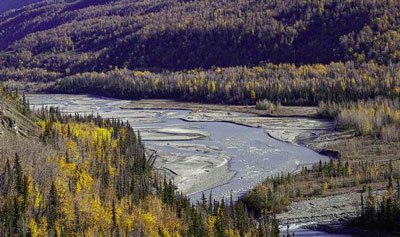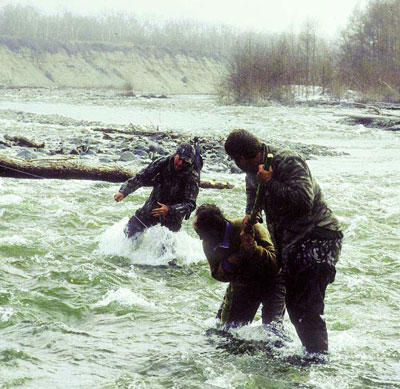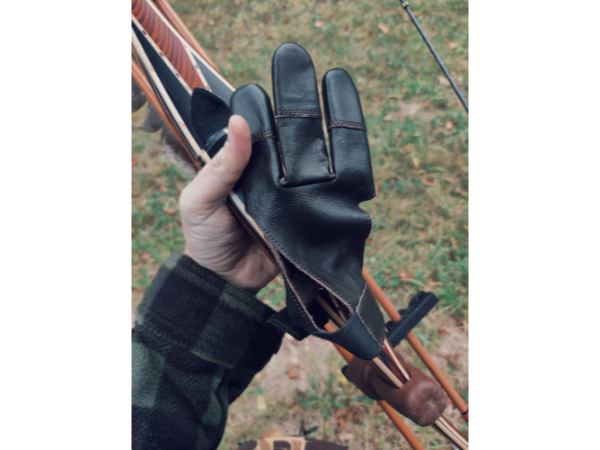There aren’t many bridges in the backcountry. Travel around much there and you’ll eventually have to cross some flowing water to get where you want to go, a process that can range from mildly inconvenient to outright dangerous. Experience eventually teaches that some ways are better than others.
In smaller streams, the only problem may be getting your feet and lower legs wet. If you can find a reasonable dry foot crossing, go for it. But when in doubt it’s usually better just to slog across, especially if you are following the course of a stream for some distance. Repeated rock-hopping invites a broken ankle. Taking your boots off and crossing barefoot in order to keep your footwear dry may sound like a good idea, but it usually isn’t. In cold mountain streams it’s hard to feel what your bare feet are doing. Unless you’re on sand or pea gravel, it’s just too easy to cut a foot or twist an ankle.
Larger streams and rivers require more thought, since the goal now is to get to the other side without going for a swim, soaking your gear, or worse. Selecting the right place to cross becomes important. There are four major factors to consider: water depth, current flow, footing, and downstream obstructions. Good water visibility will help considerably with the first and third. Turbid water—as frequently encountered during runoff or in glacial rivers—may necessitate some guesswork, in which case learning to “read” the water becomes important.

Interior Alaska. Glacial rivers like this are always dangerous to cross because of cold water, deep current, and poor visibility.
Other factors being equal, shallow water is easier to cross than deeper water because it exposes less of your surface area to the current. However, higher current flow rates can cancel that advantage. If a crossing really looks difficult, scout in both directions for places where the stream braids, allowing you to cross one segment at a time without ever having to deal with too much depth or current.
Footing is really important. In general, the smaller the rocks the easier the going, with pea gravel the best and slick, round rocks the worst. Even in the latter case, seams of sand or gravel can accumulate on the downstream side of large rocks, and if visibility allows you can sometimes pick your way across by stepping from one seam to another.
In moving water, danger always lies downstream. Avoid crossing upstream from dangerous water or obstructions like sweepers at all costs. That can mean the difference between getting wet and drowning.
A wading staff can be a tremendous asset on a tricky river crossing, and if one is good two is even better. As a lifelong fly-fisherman I grew up wading tricky water and always thought staffs were a little bit silly, but I now know better. If you don’t want to carry one on a long hike you can always fashion one on the spot, but I now find them so useful when I’m hiking in rugged terrain that I carry one (or two) almost all the time anyway.
I generally like to plan my route on a line that will lead me downstream at a moderate angle, since that will keep me moving with the flow. However, I usually keep my feet pointed upstream, so I can lean into the current. Don’t cross your feet, and don’t move your foot until you know where you’re going to put it. A wading staff will really help by allowing you to maintain a stable base while your foot does the exploring.
A heavy pack can always make an easy river crossing tough. A static line can be a big help in this situation. You’ll have to carry enough rope in your pack to stretch across the tough part, but it rarely has to cross the whole river. Send someone without a pack on across first to establish a secure point on the opposite side. If you don’t have enough rope to reach a tree, you can fashion a deadman from a stout branch. The rest of the party can then shuttle across with the packs, using the line for balance and support.
If you lose your footing and start to get swept downstream, you may need to shed your pack in a hurry. Unfasten as many straps and buckles as possible before you start. In situations like this, it’s a good idea to have a line on your pack. It’s better to have wet gear than no gear.
If you do get knocked off your feet and get swept away, remember two important points. If you’re going through rapids, lie on your back and keep your feet pointed downstream to act as shock absorbers against rocks. But if you’re headed for a sweeper, swim on your belly headfirst so you can use your hands to climb up on the obstruction.

Soviet Far East, 1991. Crossing a flooded river with a static line and deadman.
If you’re facing a really tricky crossing and have two or three hunting partners with you, form a circle by linking arms at shoulder level and leaning inward. Carry your gear on the platform made by your arms. As long as everyone hangs on and leans inward, you can support each other and your gear even if you have to bounce and bob your way downstream for a while. While I don’t recommend this technique casually, if you really, really have to cross a river it may offer you your best chance of getting to the other side.
A few words about glacial rivers are in order, especially for those who have never faced them before. Glacially fed rivers are trouble for a variety of reasons. Current flows average half again as much as in other streams. The turbid water usually makes it impossible to see the bottom, and it’s always bitterly cold. Water that looks shallow may contain channels where it’s over your head. It’s not unusual to have big rocks rolling along the bottom constantly. And newcomers to this kind of terrain—common in a lot of prime Alaska hunting country—often don’t realize how much glacial current regularly falls up and down every 24 hours.
That fluctuation arises as sun melts the ice in the glacier during the heat of the day. The intensity of the surge varies with the temperature and the amount of radiant heat, and its timing varies with your distance from the glacier. If you’re not paying attention, you can make an easy crossing when you set out in the morning only to find the river impossible to cross when you come back that night.
Fortunately, glacial rivers braid extensively, often allowing you to pick a route that crosses lots of little segments rather than one big one even if you have to do some extra hiking. Glacial silt can form quicksand where the current eddies, so be careful about setting off across bars that look like mud. If you see moose or caribou tracks ahead of you, it should be safe to cross.
All this may sound over-cautious, but it’s the real deal. I’ve had to spend a night under a tree when I neglected to calculate the daily surge in glacial current, and once I thought I was going to drown in the Yanert River, not far from the famous Little Delta that occupies such a storied place in bowhunting history. At the time, I cared a lot less about the history than about reaching the nearest bank.
For most of us most of the time, crossing streams in the backcountry won’t amount to much more than getting our feet wet. But the potential for worse is always there—drowning kills far more people in Alaska every year than bears do. The real lesson is simply that moving water deserves respect, and it always pays to stop and think before you wade into it.







On the River crossing advice , I would add: Be careful if the water is gin clear. I was steelhead fishing on the Bogachiel River in Washington about 25 years ago. The bottom consisted of egg sized gravel. The current wasn’t all that swift. I had a sturdy wading staff. After realizing that the water was a couple feet deeper than I thought, it was too late. I couldn’t back up I had to go forward. As I made for the opposite bank I found that there was a submerged log sticking out of the bank and about 2 feet below the surface. It just so happened that I was just upstream of it and could brace my thigh against it to combat the current. Had it not been there I would have been swept away. There was a log jam less than 50 yards downstream from me. Death would have been unavoidable. I hadn’t cared about the log jam because the water was so shallow or so I thought. My fishing buddy stood on the departure bank and later said he had never felt so helpless. There was nothing he could do. This was the closest to dying that I’ve ever been. That’s a profound statement because I spent over 10,000 hours crop dusting for a living. Flying under power lines for a living is about as dangerous as it gets. I’m now retired. I blow glass for a living. Meager income but much safer.
I give total credit to God for saving my life. I hadn’t seen the log until I was almost on top of it. It was a miracle that it was there, in exactly the right place.
Good article and good advice, but you have used words, like sweeper and braid, that not everyone is familiar with in this context.
Good point, Mike. As it happens, I used to fish the Bogachiel all the time when I was a kid and named my first Lab Bogey in its honor. I’ve been burned the same way several times, although never with anything worse than getting wet as a result. There’s one steelhead stream near our former Alaska home that has a hole just like that, with clear water running over pea gravel. Looks knee deep, but is chest deep. Seems like every year I try to get a little farther down to present a fly to fish I can see holding in the takeout, and still get wet every time I try. I’m glad you made it out OK.
Apologies, Custom. I use these terms so often I forget that not everyone is familiar with them. A braid is a characteristic of glacial rivers, although others can have them too. This is when the main current breaks up into multiple channels like braids in hair. A sweeper is a partially downed log in strong current, with the tip pointing downstream from the bank. Easy to get sucked into the obstruction, and this is likely the number one cause of serious accidents on river floats. Even experienced rafters and canoeists can get in big trouble quickly if they come around a bend and fine one unexpectedly. Avoid at all costs. I always assume one is waiting for me if I can’t see around the bend. Cheers, Don